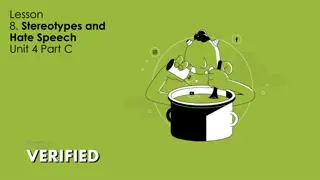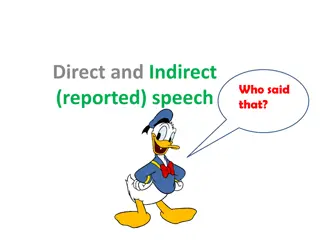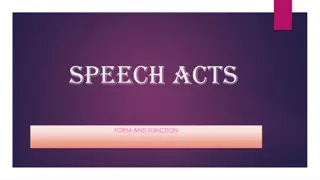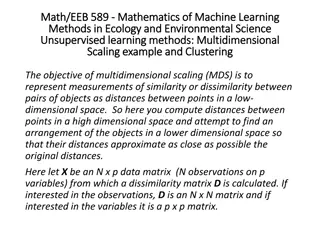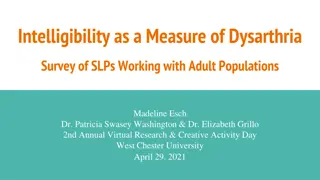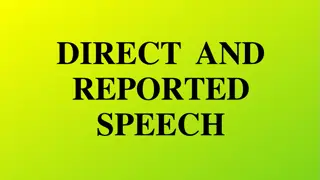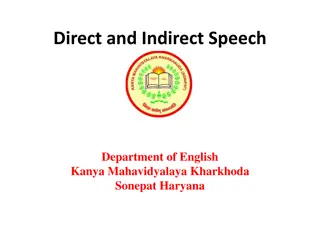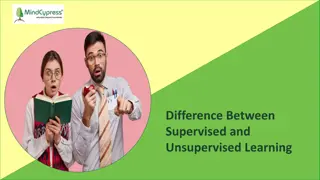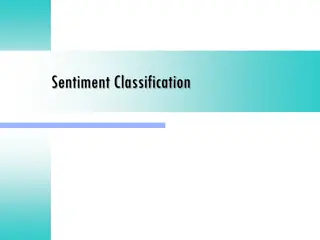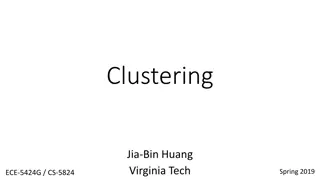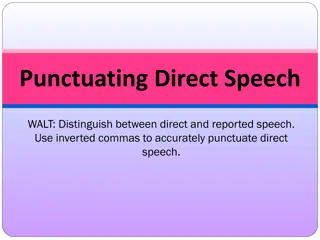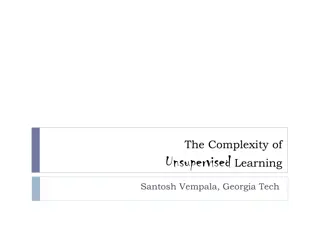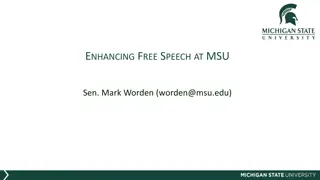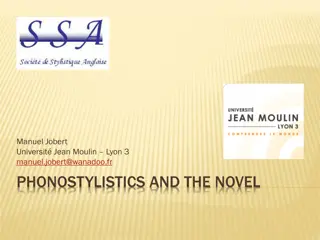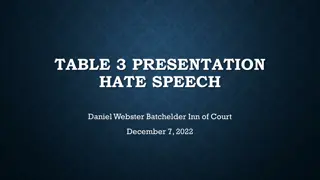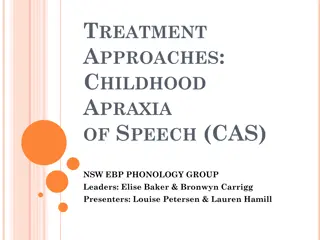Unsupervised Speech Disentanglement with SpeechSplit 2
The SpeechSplit 2 method addresses the challenge of modifying specific aspects of speech while keeping others unchanged. By leveraging techniques like VAE-based approaches, GAN-based methods, and contrastive learning, SpeechSplit 2 disentangles speech into rhythm, content, pitch, and timbre components. The proposed method improves bottleneck tuning by employing signal processing methodologies to remove pitch dynamics along time in speech, enhancing the disentanglement process.
Uploaded on Sep 20, 2024 | 1 Views
Download Presentation

Please find below an Image/Link to download the presentation.
The content on the website is provided AS IS for your information and personal use only. It may not be sold, licensed, or shared on other websites without obtaining consent from the author.If you encounter any issues during the download, it is possible that the publisher has removed the file from their server.
You are allowed to download the files provided on this website for personal or commercial use, subject to the condition that they are used lawfully. All files are the property of their respective owners.
The content on the website is provided AS IS for your information and personal use only. It may not be sold, licensed, or shared on other websites without obtaining consent from the author.
E N D
Presentation Transcript
SpeechSplit 2: Unsupervised Speech Disentanglement Without Exhaustive Bottleneck Tuning Chak Ho Chan, Kaizhi Qian, Yang Zhang, Mark Hasegawa-Johnson
Background Speech contains very rich and complex information Challenge: It is hard to modify a particular aspect of speech(duration, pitch, timbre, etc.) while keeping the others unchanged Solution: Speech Disentanglement oVAE-based(Hsu et al., 2017) oGAN-based(Zhou et al., 2020) oContrastive Learning(Ebbers et al., 2021) 2
Background (Cont.) So far, most approaches only focus on converting a single attribute(timbre) SpeechSplit(Qian et al., 2020) disentangles speech into four components: rhythm, content, pitch, and timbre 3
Background (Cont.) Why does it work? o Random resampling corrupts the rhythm information in the content and pitch encoder inputs o Carefully tune the rhythm encoder bottleneck so that it only encodes rhythm but not content/pitch/timbre o Carefully tune the content encoder bottleneck so that it only encodes content but not pitch/timbre o Carefully tune the pitch encoder bottleneck and normalize the pitch contour so that it only encodes pitch 4
Background (Cont.) Why does it work? o Random resampling corrupts the rhythm information in the content and pitch encoder inputs o Carefully tune the rhythm encoder bottleneck so that it only encodes rhythm but not content/pitch/timbre o Carefully tune the content encoder bottleneck so that it only encodes content but not pitch/timbre o Carefully tune the pitch encoder bottleneck and normalize the pitch contour so that it only encodes pitch Problem: Exhaustive bottleneck tuning 5
Proposed Method SpeechSplit 2: Solve the bottleneck tuning issue in SpeechSplit using signal processing methods Step 1: Remove the pitch dynamics along time in speech( pitch smoother ) o Analyze the signal using WORLD analyzer, which extracts spectral envelope, F0 contour, and aperiodicity o For each utterance, replace the F0 contour with its mean value o Resynthesize the signal using WORLD synthesizer 6
Proposed Method (Cont.) Step 2: Corrupt the timbre information using Vocal Tract Length Perturbation(Jaitly et al., 2013) Step 3: With both pitch and timbre components removed, randomly resample the processed spectrogram and feed it into the content encoder Step 4: Extract the corresponding spectral envelope and feed it into the rhythm encoder 7
Experiments Train both models using small and large bottleneck settings Perform subjective evaluations on Amazon Mechanical Turk(MTurk) o For each model, apply rhythm-, pitch- and timbre-only conversions between utterance pairs that are conceptually distinct in these aspects o Each pair and the converted result are presented to 5 subjects on MTurk o The subjects are asked to select which reference is closer to the converted utterance in terms of all three aspects o Measure the conversion rate, defined as the percentage of subjects who select the target utterance 8
Demo Original PS VTLP PS+VTLP 9 https://biggytruck.github.io/
Conclusion Leveraging signal processing methods, the proposed method achieves comparable performance in speech disentanglement without laborious bottleneck tuning No need to fine-tune the bottleneck for different applications and corpus Future work: apply the work to improving atypical speech recognition, e.g., dysarthric 10
References K. Zhou, Berrak Sisman, and H. Li, VAW-GAN for dis-entanglement and recomposition of emotional elementsin speech, ArXiv, vol. abs/2011.02314, 2020. K. Zhou, Berrak Sisman, and H. Li, VAW-GAN for dis-entanglement and recomposition of emotional elementsin speech, ArXiv, vol. abs/2011.02314, 2020. Janek Ebbers, Michael Kuhlmann, Tobias Cord-Landwehr, and Reinhold Haeb-Umbach, Contrastivepredictive coding supported factorized variational au-toencoder for unsupervised learning of disentangledspeech representations, in IEEEInternational Conference on Acoustics, Speech and Sig-nal Processing (ICASSP), 2021, pp. 3860 3864. Kaizhi Qian, Yang Zhang, Shiyu Chang, MarkHasegawa-Johnson, and David Cox, Unsupervisedspeech decomposition via triple information bottle-neck, inProceedings of the 37th International Con-ference on Machine Learning, 2020, pp. 7836 7846. 11
References Navdeep Jaitly and Geoffrey E. Hinton, Vocal TractLength Perturbation (VTLP) improves speech recogni-tion, inIn International Conference on Machine Learn-ing (ICML), 2013. 12
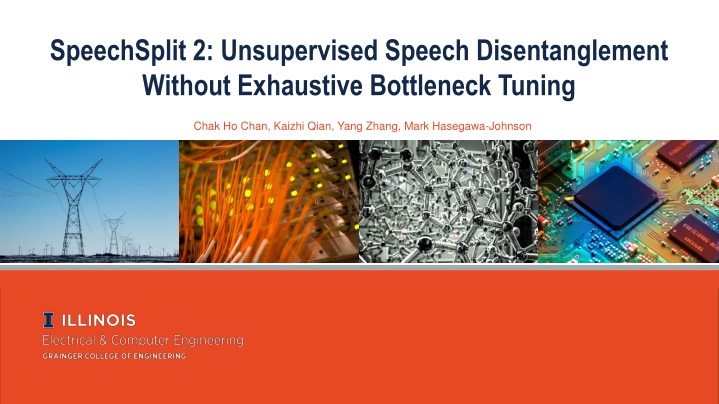

![Prevention and Combating of Hate Crimes and Hate Speech Bill [B.9B.2018]](/thumb/60513/prevention-and-combating-of-hate-crimes-and-hate-speech-bill-b-9b-2018.jpg)
